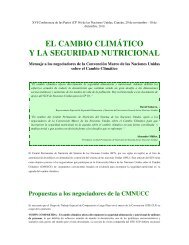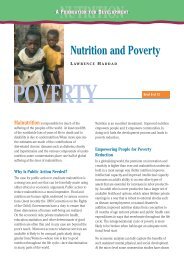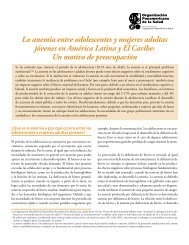SCN News No 36 - UNSCN
SCN News No 36 - UNSCN
SCN News No 36 - UNSCN
Create successful ePaper yourself
Turn your PDF publications into a flip-book with our unique Google optimized e-Paper software.
www.unsystem.org/scn FEATURES 13<br />
In general, the prevalence of severe wasting is higher at younger ages and then declines and reaches a<br />
plateau by 24 months. Conversely, stunting prevalence increases progressively until reaching a plateau at<br />
around 24 months of age (WHO 2008a). In a recent analysis, severe wasting was not accompanied by<br />
stunting in 80-100% of younger children and 40-50% of older children (Black et al 2008). Thus, identifying<br />
children who are stunted will not capture most of those who suffer from severe wasting. In addition, stunting<br />
and severe wasting are not necessarily associated on a geographical basis, that is, countries with a similar<br />
stunting rate can have considerably different prevalence of severe wasting (WHO 2008a).<br />
The great magnitude of undernutrition, which continues to hamper the growth and development of one third of<br />
the world's children, threatening their very survival, is unacceptable given the solid evidence that children from<br />
different areas and ethnic backgrounds experience very similar patterns of linear growth provided they are<br />
raised under appropriate environmental conditions (mainly proper feeding practices and free of infections).<br />
This has been shown by several studies, and more recently reconfirmed by the WHO Multicentre Growth<br />
Reference Study, where the length of children was strikingly similar among the six study sites (Figure 1) with<br />
only about 3% of variability in length being due to inter-site differences compared to 70% for individuals within<br />
sites (WHO Multicentre Growth Reference Study Group 2006). The striking similarity in growth during early<br />
childhood across human populations means either a recent common origin as some suggest (Rosenberg et al<br />
2002) or a strong selective advantage associated with the current pattern of growth and development across<br />
human environments.<br />
Projections of childhood stunting to 2015<br />
At the Millennium Summit in 2000, representatives from 189 countries committed themselves towards a world<br />
in which sustaining development and eliminating poverty would have the highest priority. The increased<br />
recognition of nutrition as a basic pillar for social and economic development placed childhood undernutrition<br />
among the targets of the first Millennium Development Goal, "to eradicate extreme poverty and<br />
hunger" (United Nations 2002). The specific target goal is to reduce by 50% the prevalence of underweight<br />
among children younger than 5 years between 1990 and 2015.<br />
Monitoring progress towards the MDG targets, requires reliable and standardized data collection systems that<br />
enable comparison over time. In an effort to monitor progress towards MDG1, we presented in 2004 estimates<br />
of global and regional trends of childhood underweight to 2015 (de Onis et al 2004b). We have since been<br />
asked how progress would be if we were to use the indicator of stunting instead of underweight. With the<br />
occasion of the 35 th <strong>SCN</strong> Session we presented these results, based on analyses of 388 national surveys from<br />
139 countries applying the same methodology as before (de Onis et al 2004b) and using the new WHO Child<br />
Growth Standards (WHO 2006). The great majority of the surveys were re-analyzed to obtain the stunting<br />
estimates based on the WHO<br />
Figure 1: Mean length (cm) from birth through two years for each of the 6 study sites. standards; however, for surveys for<br />
which the raw data were not available,<br />
Brazil<br />
Ghana<br />
the estimates were derived applying<br />
India<br />
<strong>No</strong>rway<br />
an algorithm that allows converting<br />
Oman<br />
USA<br />
estimates of child stunting based on<br />
the NCHS reference into estimates<br />
based on the WHO Child Growth<br />
Standards (Yang and de Onis 2008).<br />
Figure 2 presents projections of<br />
prevalence of stunting for 2015<br />
compared with the MDG estimate. An<br />
overall improvement in the global<br />
situation is anticipated; however,<br />
neither the world as a whole, nor the<br />
developing regions, are expected to<br />
Mean of Length (cm)<br />
50 60 70 80<br />
0 200 400 600<br />
Age (days)<br />
back to contents <strong>SCN</strong> NEWS # <strong>36</strong>

















